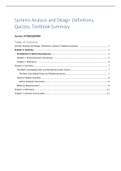Systems Analysis and Design Definitions,
Quizzes, Textbook Summary
Courses: (ICT2622)(SAND)
Table of Contents
Systems Analysis and Design Definitions, Quizzes, Textbook Summary .................................................... 1
Chapter 1: Summary .................................................................................................................................. 2
Introduction to System Development .................................................................................................... 2
Chapter 1: Review Question and Answer ................................................................................................ 3
Chapter 1: Definitions ............................................................................................................................. 6
Chapter 2: Summary ................................................................................................................................... 7
The RMO Consolidated Sales and Marketing System Project .................................................................. 7
The New Consolidated Sales and Marketing System .......................................................................... 7
Systems Analysis Activities ...................................................................................................................... 8
Gather Detailed Information ............................................................................................................... 8
What Are Requirements? ........................................................................................................................ 9
Chapter 2: Definitions ............................................................................................................................... 11
Chapter 2: Question and Answers ............................................................................................................ 12
, Chapter 1: Summary
Introduction to System Development
Systems development involves phases such as planning, analysis, design, deployment, and maintenance.
We will primarily focus on:
1. Systems analysis
2. Systems design
System Analysis
It is the process of gathering and evaluating facts, detecting problems, and breaking down a system into
its constituent parts. System analysis is performed to investigate a system or its components in order to
determine its objectives. It is a problem-solving strategy that enhances the system and guarantees that all
of the system's components operate efficiently to achieve their goals.
System Design
Systems design refers to the actions that allow a person to define in detail how an information system will
be built to offer the required answer. In other words, system design specifies how the system will
function in practice. It describes in detail all of the solution system's components and how they interact.
Systems analysis and design are critical components in the development of an information system. The
science of constructing a new structure. Consider an analogous situation: the arts and crafts. In this
scenario, there is the visionary landowner, the builder who will construct the building, and the architect
who will act as a liaison between the owner and the builder. The architect not only assists the owner in
developing the vision, but he or she must also explain the building's specs to the contractor. In doing so,
the architect use a variety of tools to first capture the owner's vision and then deliver instructions to the
builder, such as line drawings, blueprints, to-scale models, precise specifications, and even on-site
inspection reports. Just as a builder does not begin construction without designs, programmers do not sit
down and begin creating code. They require someone (maybe themselves) to do the functions of an
architect—planning, capturing the vision, understanding specifics, and identifying needs—before creating
and developing the code that fulfills the goal. This person is commonly referred to as a systems analyst. In
situations when you are both the programmer and the analyst (also known as a programmer-analyst), it
may be able to maintain track of the specifics without taking many formal notes. However, in today's
environment, where system development teams are frequently scattered globally, you may be
accountable for only a portion of the programming, with the remainder handled by team members in
different locations. It is significantly more important to generate formal requirements documents that
capture the specifications of each component in a remote team environment or with a large project.





